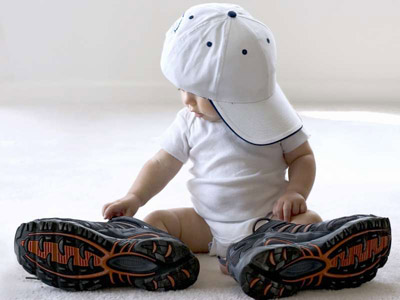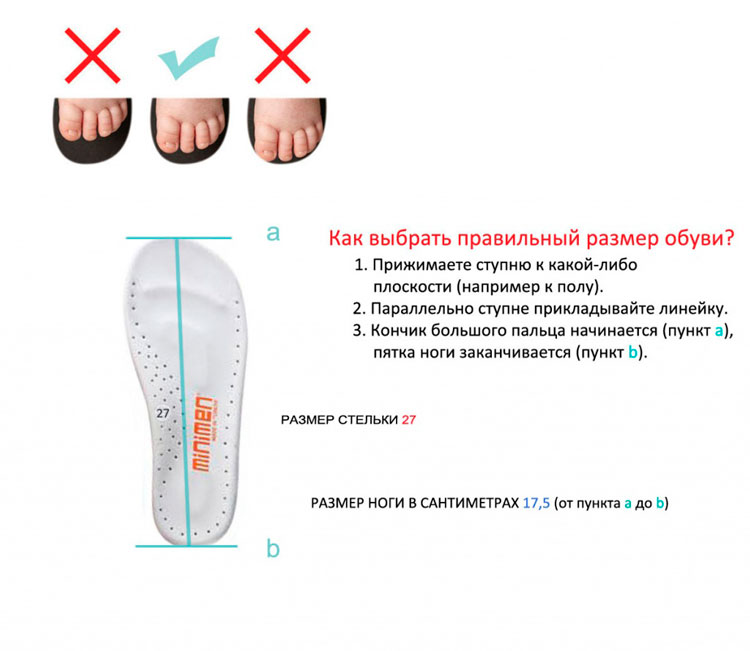How to choose shoes for a child
A trip to a children's shoe store is a true test not only for the parent, but also for the child. Unlike adults, a child does not like shopping, much less numerous fittings. At the same time, the child’s feet grow quite quickly, so you need to update your shoe wardrobe at least once a season. And here it’s up to the parent to decide how to lure their child into the store to try on several pairs of shoes, choosing the optimal size.
Naturally, it is more convenient to buy children's shoes in an online store, but here you also need to make the right choice of size. While your child is sleeping, you can pick up a new pair of sandals or boots right from home that will definitely suit him. Let's figure out how to choose shoes for a child.

What you need to know about children's feet?
Before you start directly choosing shoes, you need to know that a child’s foot develops before the age of 8 years. Until this time, a child’s foot consists of weak muscles, fragile cartilage and a layer of fat. It is at this time that it is important to choose the right shoes, taking into account the structural features of the child’s feet. Shoes should not be tight or loose, deform or squeeze the foot.
The younger the child, the faster the length of his foot changes. If you do not want to miss the moment when the shoes began to put pressure on the child, you need to regularly measure your feet:
- for children under 3 years old - every 2-3 months;
- for children from 3 to 7 years – every 4-5 months.
By the age of three, a child can change from 2 to 4 shoe sizes. In preschool age, the foot increases by approximately 2 sizes every year, and in a schoolchild - by 1-2 sizes. Let's proceed directly to choosing shoes for the child.
Selecting shoe size
When you choose sneakers, boots or other shoes, you must leave a margin of 0.5-1 centimeter. If the model is exactly the right size or fits snugly, it’s not worth buying. And here the point is not only about saving, but also about the fact that during the heat the child’s foot will swell, increasing in size, so the foot and toes need additional space for movement. You can wear shoes until they fit snugly, but they should not put pressure on your heel or toes.
Do not buy shoes with a large margin - more than 1 centimeter, because... the instep support will be in the wrong place, which can negatively affect the formation of the foot. The child will constantly stumble, hit the capes, and an incorrect gait may develop. In general, sizing looks like this:
- you need to put a sheet of paper on the floor;
- you need to place the child’s foot on the paper so that all points of the foot are evenly pressed against the floor;
- circle the outline of the child’s foot - the pencil should be strictly perpendicular to the floor, then start drawing from the middle of the heel, first going along the inside of the foot;
- measure the length of the print along the most protruding points in the picture;
- repeat the procedure with the other leg - the indicator may differ, and in some cases up to 5 mm;
- select the optimal indicator, which, if necessary, simply round up.
With these indicators you can determine the size in the size chart. Sometimes a wet footprint on newspaper or paper is used to measure a child's foot size. The third method is to use a specially designed measure, where there is a special scale in centimeters and millimeters.
Regardless of the measurement option, it is necessary that the child stands confidently on both legs - in this position the width and length of the leg will be slightly greater. You need to add 5-8 mm to the results obtained, after which you can determine the shoe size in centimeters.

Choosing a shoe shape
One of the main conditions is that the child’s shoes must have a wide toe box. The structure of a child's foot differs from that of an adult foot, and space is important for children's toes, that is, the presence of a wide toe. If the toe is narrow, blood circulation will be impaired and the load will not be distributed over the entire foot. In the right shoes, the big toe should not be pressed tightly against the other toes. This rule applies to absolutely all shoes for a child, from sandals to sneakers and boots.
Hard rear
This element in the shoe is intended for the ankle - a hard heel. Do not confuse with the top of the beret, because... it should be soft so as not to rub the delicate baby skin. For children under 5 years old, there is no need to purchase shoes that have an open heel or a strap on the heel, because... such a backdrop will not be able to provide the necessary fixation of the ankle. Such shoes can only be used for short-term wear - in the pool or on the beach. The popular opinion is that a child needs shoes exclusively with a high top that will fix and cover the ankle - this is true if the orthopedist has prescribed such shoes. And restricting a healthy joint will only disrupt its development.
Lift and fullness
Buying shoes by size is not so bad; you also need to choose a model based on size, which is quite difficult. This is especially true for children with high arches or full legs. With sandals with 2-3 Velcro - everything is clear here, adjusting them on the foot is quite simple, but what to do with other shoes. Shoes are not suitable if:
- too difficult to go inside;
- the leg wobbles and dangles when walking;
- if when you press the sides, something like a “bubble” is formed.
Material
If you want to buy children's shoes that will not harm the child, then it is optimal to choose textiles or genuine leather. Any mother knows that such material is plastic, stretchable, and can also ensure optimal air circulation. Only decorations on shoes are allowed made of artificial leather. Many sellers use tricks, for example, they write that they sell shoes made of genuine leather, but in fact they are only natural on the outside, and the inside is synthetic, or they use split leather. An excellent solution would be textile shoes, which will be an indispensable solution for walking and playing, or for wearing at home - slippers. The disadvantage of such shoes is that it is impossible to create a hard back in textile shoes, and this is important for a child.

Upper part of the shoe
The fastening of the upper part can be different - zipper, clasp, Velcro or laces. The most comfortable shoes for a child are shoes with Velcro - they simply fasten and unfasten. But orthopedists believe that it is advisable to buy shoes with laces - they fit better to the child’s feet. The fastener can only be used for winter and demi-season shoes, and in other cases it is inconvenient.
Shoe sole
The main requirement for the sole is that it must be flexible, grooved and wear-resistant. Only if these three rules are met, then you get high quality shoes. The flexible sole should only be in the place where the foot bends - the place of the toes and arch. You can check the level of flexibility by bending the sole in these places. If the sole bends in all places, then the child’s foot may not form correctly. It is not recommended to wear such shoes all the time.
The sole is made from genuine leather, rubber, thermoplastic elastomer, polyurethane, PVC, as well as a combination of these materials. If a child takes his first steps, then a sole made of genuine leather will be optimal - it breathes. PVC shoes will be the optimal solution for wearing indoors, for example, in a kindergarten - they do not draw. There are no special rules for choosing the sole material. Every material can provide comfort if it is of high quality.
Conclusions
If you follow all these rules, you will be able to choose and buy shoes for your child with a minimum of whims and maximum benefit for your child. And our online store will make sure that you can buy children's shoes from famous brands with maximum comfort. Not only do we offer certified products, but we are also always ready to help during the selection process. We will advise you on all questions of interest. We deliver to any point in Ukraine.
